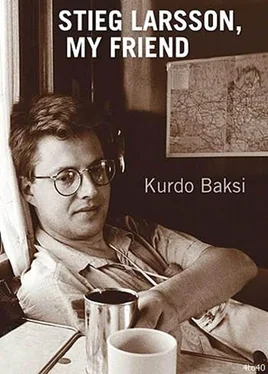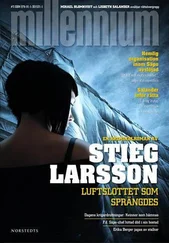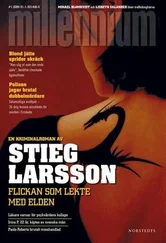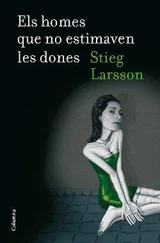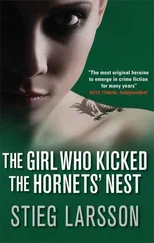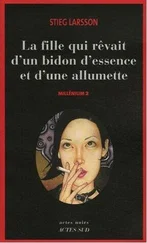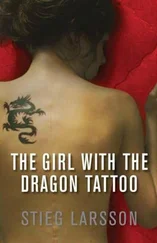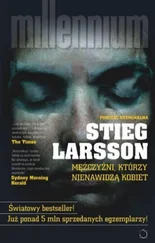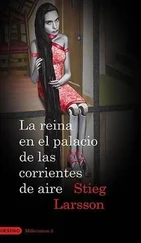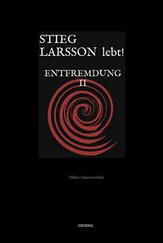Starting something from nothing has advantages and disadvantages. It can be time-consuming to procure the resources necessary to make a project happen, but it is also stimulating to realize exactly what you have envisaged. Along with the others, Stieg threw himself wholeheartedly into Expo . There were big problems to solve and minor matters to sort out – the bottom line was that everything needed to be resolved in the shortest possible time.
The first matter to be tackled was ownership. The first owner was the Hill Foundation, which eventually became the Expo Research Foundation. Next, Expo ’s remit was spelled out:
… to study and survey anti-democratic, right-wing extremist and racist tendencies in Swedish society. All activities are idealistic and non-profit-making. The foundation’s policy is to safeguard democracy and freedom of expression against racist, right-wing extremist, anti-Semitic and totalitarian tendencies in society. Expo has no links to specific parties or political groups, but cooperates with all individuals and groups that share the foundation’s philosophy.
A lot of effort went into raising the necessary capital, not least in order to begin the intensive work on creating an international archive comprising thousands of books, posters, magazines, newspaper articles, videos, records and photographs linked in one way or another to racism, neo-Nazism and far-right extremism. The archive soon became unique and irreplaceable. There was only one problem: the costs had got out of hand.
Expo moved first into basement premises in Lundagatan in the Södra district of Stockholm (Lisbeth Salander’s first flat was located in the very same street); by the end of 1995 they had moved to a cheaper basement at Färggårdstorget 32, in the Skanstull district. That same year saw the publication of the first issue. One of the pictures in it showed a person giving the Nazi salute, but hiding his face behind a partially open door.
The editorial board could not possibly have imagined the success they went on to achieve with their first thirty-two pages. Stieg wrote the leading article about the horrific bomb outrage in Oklahoma City in April 1995, which cost 168 lives. The board was delighted to note that the matters they took up in that first issue were being discussed in lively debates in schools and workplaces, by trade unions and political parties.
The journal immediately attracted large numbers of subscribers, several of whom paid more than the nominal fee in order to demonstrate their support. But there were also critical voices. Some commentators felt that Expo had acted in an unethical way and gone too far in its efforts to track down racist networks. Every journal with high ideals can expect criticism; much worse were the constant threats. Needless to say, a magazine that devotes so much effort to identifying racist and neo-Nazi activities will create enemies. The last thing people involved in such activities want is to find themselves in the spotlight. And they think nothing of resorting to violent tactics.
From the very start Expo ’s staff were labelled as “traitors” in neo-Nazi publications, and countless defamatory letters were sent to newspaper editors and to parliamentary parties and their youth sections. The first organized hate campaign took place in May of 1996 – fifteen months after Expo ’s launch – when the magazine’s printer’s premises were sabotaged. Every window was smashed and totally demolished using glass-cutters, in order to demonstrate how easily the building could be entered if the firm continued to print Expo . Retailers offering Expo for sale suffered similar attacks and walls were sprayed with the message “Don’t Print Expo !”
Of course, attacks of this kind often have a positive side: they set people talking. The subsequent debate means that editors and commentators are forced to take sides, and that in turn leads to discussion points rising to the surface. Very few people want to live in a society where you put your life in danger by printing a magazine.
In any case, it was obvious that a lot of people were actually jealous of all the attention Expo had been lucky enough to attract in such a short time. Some commentators stood the situation on its head and wondered how much support a right-wing-extremist equivalent of Expo would receive if it suffered a similar attack. Expo ’s new editor-in-chief, Andreas Rosenlund, made several brilliant contributions to the debate that followed. He summarized the situation by pointing out that “instead of trying to conduct a democratic exchange of views, these people turn to gangster tactics”.
Despite all the support the journal received during these difficult weeks, nobody was able to convince the printers that it was a price worth paying for freedom of speech. They had been so scared that they felt obliged to cancel their contract with Expo .
It was not necessary to call in a world-class sleuth in order to work out who was behind the campaign of violence directed at retailers selling Expo . The neo-Nazi newspaper Info-14 – which, remarkably enough, produced its first edition the same year, 1995 – reported promptly and in detail on how the attacks had been carried out, going so far as to propose new targets. As well as being a newspaper, Info-14 was a political outlet for the National Alliance. Its founder, Robert Vesterlund, was also chairman of Sweden Democratic Youth. The police interrogated large numbers of people associated with the newspaper, but never managed to bring anybody to trial.
As so often happens, the racist attacks had the opposite effect to what had been intended. On 10 June, 1996, the editorial boards of Sweden’s two biggest evening newspapers, Aftonbladet and Expressen , decided to demonstrate their solidarity with Expo by publishing and distributing without charge an edition of the journal together with one of their own issues, with a print run of over eight hundred thousand.
Expo ’s list of subscribers increased significantly, and the smile on Stieg’s lips became broader than ever. He even plucked up enough courage to joke about the thugs threatening him, calling them his “prey”. They consisted of a motley collection of latent neo-Nazis in Strängnäs, active neo-Nazis and members of the National Socialist Front in Skåne, and lunatics in the Keep Sweden Swedish organization in Uppsala, Västerås and Helsingborg. Several of them were subscribers, even though their motivation had nothing to do with boosting Expo ’s finances. They would open each new issue in a state of expectancy: would fingers be pointed at them in one of the articles? Some of them considered it a significant milestone in their careers as racists, being mentioned by name in Expo . No doubt many of them were excused from paying for a round or two of beer in pubs in Skåne and Östgötaland as a result.
Sad to say, however, the attacks on printing works and retail outlets were only the beginning. It was not long before worse atrocities took place, often in Stieg’s and my backyard. I am sometimes shattered by memories of what happened in those days.
A cursory glance at press cuttings from the time reveals a remarkable phenomenon. Quite a lot of people in Sweden are murdered by neo-Nazis shortly after parliamentary elections. According to statistics, the year after an election can be critical for people who don’t “look Swedish” and who have names that are difficult to pronounce, Swedish anti-racists, anybody who has adopted a non-Scandinavian child, local politicians and journalists who expose racist tendencies.
Of all the horrific racist outrages, one stands out. It took place on 16 August, 1995, at Lake Ingetorp in Kode, near Gothenburg. A fourteen-year-old boy, John Hron, had gone there camping with a friend. They had been looking forward to this outing, but the situation changed drastically when four young neo-Nazis turned up. The two boys were subjected to psychological and physical torture for three hours. John escaped by swimming out into the lake, but was forced to return when the neo-Nazis threatened to kill his friend. He swam back, at which point they turned their full attention on him. Having allowed his friend to escape, they subjected John to sophisticated torture: they would beat and kick him for a while, then change tactics and speak nicely to him, offering him a beer. In the end, having rendered him unconscious, they threw him into the water and watched him drown.
Читать дальше
